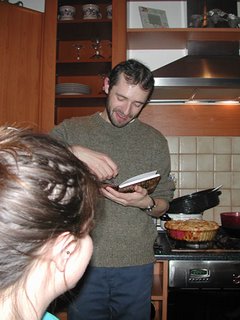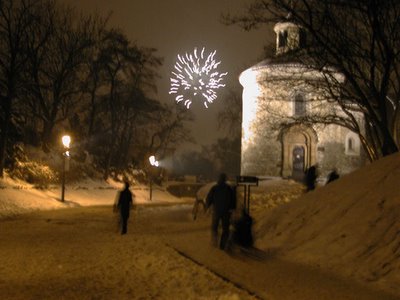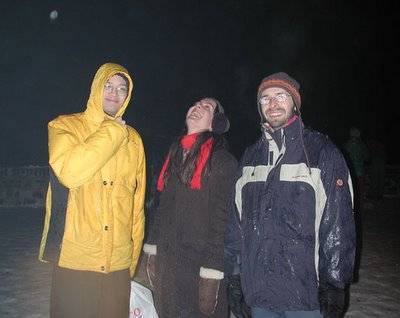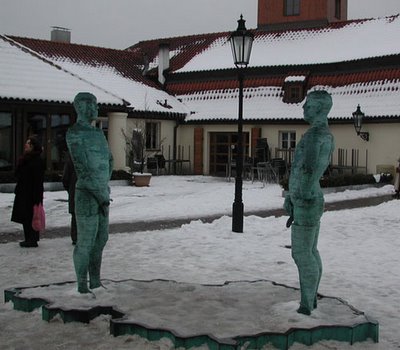Silvestr at Karla's House of Pleasure
New Year’s Eve is celebrated in the Czech Republic much as in the United States, but by the name of Silvestr. A great many people do nothing in particular beyond staying home and watching TV (endless Silvestr specials featuring every Czech entertainer imaginable, with flashbacks to Silvestr specials from the distant past). Other people, however, go out to restaurants and parties and suchlike. I gather that Staroměstské náměstí and Václavské náměstí become a seething mass of international drunkenness.
It occurred to Jesse and me, however, that New Year’s Eve would be an ideal time to prepare another feast in my kitchen. After a visit to the grocery stores for ideas, I formulated a menu of leek and potato soup, roasted vegetables, risotto, cranberry sauce, and a plum, apple, and cranberry pie. Several other Fulbright grantees were bound to be available to join us (as indeed they were).
 The soup was put off on the grounds that it looked like there would be a massive amount of food without it, but everything else went together without any problem, despite the fact that Jesse’s train was delayed significantly (permitting him to watch a dog fight at the Brno train station and consider acquiring Jehovah’s Witness information on Armageddon to pass the time). When he arrived, I put him in charge of the pie crust as presumably this one would not self-destruct (it did not).
The soup was put off on the grounds that it looked like there would be a massive amount of food without it, but everything else went together without any problem, despite the fact that Jesse’s train was delayed significantly (permitting him to watch a dog fight at the Brno train station and consider acquiring Jehovah’s Witness information on Armageddon to pass the time). When he arrived, I put him in charge of the pie crust as presumably this one would not self-destruct (it did not).
Dawn was the first guest to arrive, as she had another engagement to attend, so round one of the dinner was eaten.
Shortly after her departure, Hubert arrived. He had been slaving over a string quartet and required a break from the rigors of composition, so I began to tell him about the interesting museum Megan and I had visited the previous day.
Megan then called from the tram stop for further directions, so, as my hands were covered with plum, Hubert picked up the phone. “Karla’s House of Pleasure,” said he. (Megan had to give the rest of the details of the museum herself.)
 Phase two of dinner was successful and suitably merry. Jesse had found a remarkable volume in a Brno bookstore, the Hudební atlas hub (musical atlas of mushrooms), whose author has composed music for each of numerous types of mushroom.
Phase two of dinner was successful and suitably merry. Jesse had found a remarkable volume in a Brno bookstore, the Hudební atlas hub (musical atlas of mushrooms), whose author has composed music for each of numerous types of mushroom.  We examined this singular work and also played selections from the accompanying CD. Unfortunately the CD player on my laptop was being a little finicky, but the pieces sounded listenable.
We examined this singular work and also played selections from the accompanying CD. Unfortunately the CD player on my laptop was being a little finicky, but the pieces sounded listenable.
Hubert had brought along some DVDs, so we then watched Kalamita, an older Věra Chytilová film starring the ever-popular Bolek Polívka. It was pretty good, although I gather it was very different from some of the director’s other films. The ending was a bit dull in comparison to the rest.
At that point, it seemed about time to head over to Vyšehrad, which Věra had told me was a popular place for less crazy Silvestr celebrations. The Vyšehrad fortifications are about a mile north of my apartment—a nice walk, generally. There was a bit of precipitation of the rain (versus snow) variety, but not enough to warrant umbrellas. Some of the streets in Podolí had Christmas decorations up, and as we approached Vyšehrad we came across others headed in the same direction.
Up on the ramparts there were lots of people looking out over the city, many of them shooting off fireworks. I am really not accustomed to being in close range of fireworks, but on the whole I felt much safer than I would have expected, as the fireworks (many of them the kind I would only expect to see at a municipal display) were mostly set off into the distance. People on other high ground around Prague were doing the same, so the show was quite impressive until fog and smoke took over the atmosphere. Even then, it was still worth watching. People were animated but, as Věra had indicated, not wildly out of control.
 Decorations in Podoli
Decorations in Podoli
 Fireworks on the way up to Vyšehrad
Fireworks on the way up to Vyšehrad
 Up at Vyšehrad
Up at Vyšehrad
 The police watch fireworks
The police watch fireworks
When we began to head back, we found that the cobblestones had gotten really icy. While we made it safely back to my apartment, the journey was a bit hazardous and there were a few falls and near-misses.
Under these circumstances, it seemed pointless for Hubert to go home, so I had three overnight guests. This certainly called for prompt deployment of Hovoříme s hostem, but I didn’t think of that, merely of which bedding I could bring forth. (I am glad that Sandra owns what would usually appear to be a surplus of pillows and pillow cases, so no one had to go without these.) The living-room supply of Cosmopolitan provided bedtime reading matter for those who had not brought their own or who were not in the mood for volume 3 of Karel Teige’s writings on art.
In the morning, I fed my guests coffee, tea, and a ten-egg omelet or frittata (there was some discussion as to which it was). Hubert proved to be a most meticulous onion-slicer.
 Megan told us that she had run across a blog with a photo of a most peculiar fountain, which we agreed we ought to make a resolution to find and photograph that very day. Megan was able to find the blog with the photo, but no precise address was given. There was, however, a link to the artist’s website—it proved, not surprisingly (to me), to be a recent work by the Prague sculptor David Černý. (Černý is one of the best-known contemporary sculptors here, and does pretty interesting and often satirical stuff. I got to hear him talk about his work when my Czech course visited him in 2003. On the whole, I like what he does. He is especially known for having painted a statue of a Soviet tank pink.) We thought that as it sounded like the sculpture was on the Kampa, we could probably find it.
Megan told us that she had run across a blog with a photo of a most peculiar fountain, which we agreed we ought to make a resolution to find and photograph that very day. Megan was able to find the blog with the photo, but no precise address was given. There was, however, a link to the artist’s website—it proved, not surprisingly (to me), to be a recent work by the Prague sculptor David Černý. (Černý is one of the best-known contemporary sculptors here, and does pretty interesting and often satirical stuff. I got to hear him talk about his work when my Czech course visited him in 2003. On the whole, I like what he does. He is especially known for having painted a statue of a Soviet tank pink.) We thought that as it sounded like the sculpture was on the Kampa, we could probably find it.
Off we went. The Kampa is not large, although it is somewhat labyrinthine. We explored the section south of the Charles Bridge exhaustively without finding any sign of our quarry. Perhaps it was simply in greater Malá Strana and not on the Kampa. We left the Kampa and found Shakespeare and Co. bookstore, which met with our approval. We then saw another sign for Kampa and followed it. Eventually, in the courtyard of the new Kafka Museum (I am not sure how many Kafka Museums there now are in Prague), we found our statue. Unfortunately, it being winter, the fountain and mechanical parts were not in use. We did, however, take quite a few pictures, after which it seemed like time for more food.
 After this meal, Hubert decided it was time to return to his string quartet, and the rest of us met up with Dawn to watch Corpse Bride in Smíchov.
After this meal, Hubert decided it was time to return to his string quartet, and the rest of us met up with Dawn to watch Corpse Bride in Smíchov.  The tickets were exorbitantly priced, but the movie was rather fun.
The tickets were exorbitantly priced, but the movie was rather fun.
Megan really did have to get back to Kutná Hora, so after bidding Dawn adieu, Jesse and I accompanied her to the Hlavní nádraží. We did this not because Megan cannot get to the train station by herself, but because the three of us had formulated a plan for anthropological observation of the train station’s clientele. Not the ordinary travelers, of course, but the seedy characters who spend lots of time there. On this expedition, however, we did not see anything too remarkable. One homeless person had brought his own lawn chair to sit on, which I expect was more comfortable than the slab his companions were seated on. Unfortunately capitalism has brought its evils as well as its benefits to the Czech Republic, and thus there are now homeless people who need a warm place to stay on winter nights.
We are not very thorough anthropologists, however, so shortly after Megan’s departure Jesse and I returned to my apartment and watched Balada pro banditu. This classic musical was filmed in the 1970s and is still performed as a stage play (See Jesse's review of a recent instance) but neither of us had seen the film. While the story is set in Ruthenia during the First Republic, the film has a rather sweet and very 1970s counterculture ambience. Even with the English subtitles, I thought most of the plot and exposition had evaporated; without Jesse’s greater knowledge of the story, I would have been baffled. At the same time, we found it very enjoyable to watch and listen to. It has a nonrealistic, poetic atmosphere (imagine Robin Hood and his Merry Men out in the forest, but at a 1970s Renaissance Faire), and Bolek Polívka gives a memorable performance as Mageri the Jew. It made a pleasant end for New Year’s Day and the music at the end of the DVD loops so skillfully and is so lulling that there is no need to turn it off immediately, especially if (as is normally the case in my living room here) the film is being watched by candlelight. You can just sit there and watch the candle flames and listen. Thoughts of archival research have retreated far into the back of the mind, as should generally be the case over the holidays.
(And now: you are growing v e r y s l e e p y…)
 The water wheel at the Kampa
The water wheel at the Kampa
Note: You can see a photo Dawn took of us here.
And Jesse has now written about Silvestr, also with photos.
And Megan also writes about Silvestr, using some familiar photos.
It occurred to Jesse and me, however, that New Year’s Eve would be an ideal time to prepare another feast in my kitchen. After a visit to the grocery stores for ideas, I formulated a menu of leek and potato soup, roasted vegetables, risotto, cranberry sauce, and a plum, apple, and cranberry pie. Several other Fulbright grantees were bound to be available to join us (as indeed they were).
 The soup was put off on the grounds that it looked like there would be a massive amount of food without it, but everything else went together without any problem, despite the fact that Jesse’s train was delayed significantly (permitting him to watch a dog fight at the Brno train station and consider acquiring Jehovah’s Witness information on Armageddon to pass the time). When he arrived, I put him in charge of the pie crust as presumably this one would not self-destruct (it did not).
The soup was put off on the grounds that it looked like there would be a massive amount of food without it, but everything else went together without any problem, despite the fact that Jesse’s train was delayed significantly (permitting him to watch a dog fight at the Brno train station and consider acquiring Jehovah’s Witness information on Armageddon to pass the time). When he arrived, I put him in charge of the pie crust as presumably this one would not self-destruct (it did not).Dawn was the first guest to arrive, as she had another engagement to attend, so round one of the dinner was eaten.
Shortly after her departure, Hubert arrived. He had been slaving over a string quartet and required a break from the rigors of composition, so I began to tell him about the interesting museum Megan and I had visited the previous day.
Megan then called from the tram stop for further directions, so, as my hands were covered with plum, Hubert picked up the phone. “Karla’s House of Pleasure,” said he. (Megan had to give the rest of the details of the museum herself.)
 Phase two of dinner was successful and suitably merry. Jesse had found a remarkable volume in a Brno bookstore, the Hudební atlas hub (musical atlas of mushrooms), whose author has composed music for each of numerous types of mushroom.
Phase two of dinner was successful and suitably merry. Jesse had found a remarkable volume in a Brno bookstore, the Hudební atlas hub (musical atlas of mushrooms), whose author has composed music for each of numerous types of mushroom.  We examined this singular work and also played selections from the accompanying CD. Unfortunately the CD player on my laptop was being a little finicky, but the pieces sounded listenable.
We examined this singular work and also played selections from the accompanying CD. Unfortunately the CD player on my laptop was being a little finicky, but the pieces sounded listenable.
Hubert had brought along some DVDs, so we then watched Kalamita, an older Věra Chytilová film starring the ever-popular Bolek Polívka. It was pretty good, although I gather it was very different from some of the director’s other films. The ending was a bit dull in comparison to the rest.
At that point, it seemed about time to head over to Vyšehrad, which Věra had told me was a popular place for less crazy Silvestr celebrations. The Vyšehrad fortifications are about a mile north of my apartment—a nice walk, generally. There was a bit of precipitation of the rain (versus snow) variety, but not enough to warrant umbrellas. Some of the streets in Podolí had Christmas decorations up, and as we approached Vyšehrad we came across others headed in the same direction.
Up on the ramparts there were lots of people looking out over the city, many of them shooting off fireworks. I am really not accustomed to being in close range of fireworks, but on the whole I felt much safer than I would have expected, as the fireworks (many of them the kind I would only expect to see at a municipal display) were mostly set off into the distance. People on other high ground around Prague were doing the same, so the show was quite impressive until fog and smoke took over the atmosphere. Even then, it was still worth watching. People were animated but, as Věra had indicated, not wildly out of control.
 Decorations in Podoli
Decorations in Podoli Fireworks on the way up to Vyšehrad
Fireworks on the way up to Vyšehrad Up at Vyšehrad
Up at Vyšehrad The police watch fireworks
The police watch fireworksWhen we began to head back, we found that the cobblestones had gotten really icy. While we made it safely back to my apartment, the journey was a bit hazardous and there were a few falls and near-misses.
Under these circumstances, it seemed pointless for Hubert to go home, so I had three overnight guests. This certainly called for prompt deployment of Hovoříme s hostem, but I didn’t think of that, merely of which bedding I could bring forth. (I am glad that Sandra owns what would usually appear to be a surplus of pillows and pillow cases, so no one had to go without these.) The living-room supply of Cosmopolitan provided bedtime reading matter for those who had not brought their own or who were not in the mood for volume 3 of Karel Teige’s writings on art.
In the morning, I fed my guests coffee, tea, and a ten-egg omelet or frittata (there was some discussion as to which it was). Hubert proved to be a most meticulous onion-slicer.
 Megan told us that she had run across a blog with a photo of a most peculiar fountain, which we agreed we ought to make a resolution to find and photograph that very day. Megan was able to find the blog with the photo, but no precise address was given. There was, however, a link to the artist’s website—it proved, not surprisingly (to me), to be a recent work by the Prague sculptor David Černý. (Černý is one of the best-known contemporary sculptors here, and does pretty interesting and often satirical stuff. I got to hear him talk about his work when my Czech course visited him in 2003. On the whole, I like what he does. He is especially known for having painted a statue of a Soviet tank pink.) We thought that as it sounded like the sculpture was on the Kampa, we could probably find it.
Megan told us that she had run across a blog with a photo of a most peculiar fountain, which we agreed we ought to make a resolution to find and photograph that very day. Megan was able to find the blog with the photo, but no precise address was given. There was, however, a link to the artist’s website—it proved, not surprisingly (to me), to be a recent work by the Prague sculptor David Černý. (Černý is one of the best-known contemporary sculptors here, and does pretty interesting and often satirical stuff. I got to hear him talk about his work when my Czech course visited him in 2003. On the whole, I like what he does. He is especially known for having painted a statue of a Soviet tank pink.) We thought that as it sounded like the sculpture was on the Kampa, we could probably find it.Off we went. The Kampa is not large, although it is somewhat labyrinthine. We explored the section south of the Charles Bridge exhaustively without finding any sign of our quarry. Perhaps it was simply in greater Malá Strana and not on the Kampa. We left the Kampa and found Shakespeare and Co. bookstore, which met with our approval. We then saw another sign for Kampa and followed it. Eventually, in the courtyard of the new Kafka Museum (I am not sure how many Kafka Museums there now are in Prague), we found our statue. Unfortunately, it being winter, the fountain and mechanical parts were not in use. We did, however, take quite a few pictures, after which it seemed like time for more food.
 After this meal, Hubert decided it was time to return to his string quartet, and the rest of us met up with Dawn to watch Corpse Bride in Smíchov.
After this meal, Hubert decided it was time to return to his string quartet, and the rest of us met up with Dawn to watch Corpse Bride in Smíchov.  The tickets were exorbitantly priced, but the movie was rather fun.
The tickets were exorbitantly priced, but the movie was rather fun.Megan really did have to get back to Kutná Hora, so after bidding Dawn adieu, Jesse and I accompanied her to the Hlavní nádraží. We did this not because Megan cannot get to the train station by herself, but because the three of us had formulated a plan for anthropological observation of the train station’s clientele. Not the ordinary travelers, of course, but the seedy characters who spend lots of time there. On this expedition, however, we did not see anything too remarkable. One homeless person had brought his own lawn chair to sit on, which I expect was more comfortable than the slab his companions were seated on. Unfortunately capitalism has brought its evils as well as its benefits to the Czech Republic, and thus there are now homeless people who need a warm place to stay on winter nights.
We are not very thorough anthropologists, however, so shortly after Megan’s departure Jesse and I returned to my apartment and watched Balada pro banditu. This classic musical was filmed in the 1970s and is still performed as a stage play (See Jesse's review of a recent instance) but neither of us had seen the film. While the story is set in Ruthenia during the First Republic, the film has a rather sweet and very 1970s counterculture ambience. Even with the English subtitles, I thought most of the plot and exposition had evaporated; without Jesse’s greater knowledge of the story, I would have been baffled. At the same time, we found it very enjoyable to watch and listen to. It has a nonrealistic, poetic atmosphere (imagine Robin Hood and his Merry Men out in the forest, but at a 1970s Renaissance Faire), and Bolek Polívka gives a memorable performance as Mageri the Jew. It made a pleasant end for New Year’s Day and the music at the end of the DVD loops so skillfully and is so lulling that there is no need to turn it off immediately, especially if (as is normally the case in my living room here) the film is being watched by candlelight. You can just sit there and watch the candle flames and listen. Thoughts of archival research have retreated far into the back of the mind, as should generally be the case over the holidays.
(And now: you are growing v e r y s l e e p y…)
 The water wheel at the Kampa
The water wheel at the KampaNote: You can see a photo Dawn took of us here.
And Jesse has now written about Silvestr, also with photos.
And Megan also writes about Silvestr, using some familiar photos.
Labels: art, bizarre, Czech, film, food, friends, holidays, music, Prague, winter

0 Comments:
Post a Comment
<< Home